Great Neck South, Ward Melville win regional Science Bowls at BNL
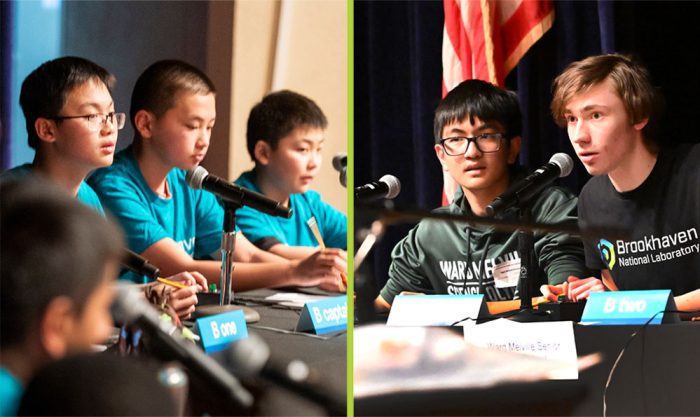
Both teams will compete for the National Science Bowl title in April
Bright minds from Great Neck South Middle School and Ward Melville High School won first place at regional middle and high school Science Bowls — fast-paced question-and-answer academic competitions — hosted by the U.S. Department of Energy’s (DOE) Brookhaven National Laboratory in Upton on Jan. 30 and Jan. 31.
The Science Bowl tests students’ knowledge on a range of science disciplines including chemistry, biology, physics, mathematics, astronomy, earth, and computer science.
The teams’ first place wins secured them an all-expense-paid trip to the National Science Bowl, where they’ll compete with students from around the country. The National Science Bowl is scheduled to take place from April 24 to April 28 near Washington, D.C.
“The regional Science Bowl competition brings together some of the best and brightest STEM students from our region. We must inspire these students by highlighting career pathways and training opportunities, setting them on the path to become the next generation of STEM professionals,” said competition coordinator Amanda Horn, an educator with Brookhaven’s Workforce Development and Science Education Office.
The winning teams also received a banner to hang in their schools, the top four teams received trophies, and the top three received medals. The first-place high school team won $500 and the second-place team won $250. All prizes and giveaways are courtesy of the event’s sponsors, Brookhaven Science Associates and Teachers Federal Credit Union.
Middle School Science Bowl Top Four
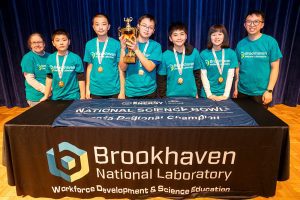
The regional middle school Science Bowl on Jan. 30 was open to schools from Long Island and New York City.
Team members from Great Neck South Middle School spent hours the day before the middle school competition studying as much as they could, said student Ryan Tsai. Each team member specialized in a different subject.
“I would like to thank the math people for doing math,” said Tsai, who focused on chemistry questions.
Looking ahead to the National Science Bowl, captain Nathan Li added, “We’re looking forward to not getting last place and also just having a good time.”
First Place: Great Neck South MS (Team 1)
Second Place: Hunter College MS
Third Place: Paul J. Gelinas JHS
Fourth Place: R.C. Murphy JHS
High School Science Bowl Top Four
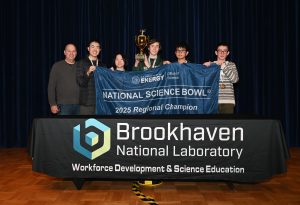
Ward Melville Senior High School is sending a team to the National Science Bowl for the third straight year.
To prepare for the regional high school competition on Jan. 31, the team studied even more than they did last year since two previous members graduated since then, said captain Sean Skinner. They also practiced how to buzz in to answer questions as fast as possible, he said.
“Most of us have read a textbook cover to cover in our main fields,” Skinner said, noting that each team member specialized in a subject or two. He added that he was happy with the teamwork Ward Melville showed. “Everyone was really positive and focused; that was awesome to see,” Skinner said. “I think my favorite thing is working together with other people to solve a problem that goes between both of your skills.”
First Place: Ward Melville Senior HS
Second Place: Great Neck South HS
Third Place: Roslyn High School
Fourth Place: General Douglas MacArthur Senior High School
Encouraging STEM participation
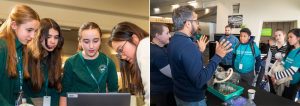
Both competitions kicked off with an introduction to Brookhaven Lab’s role as one of 17 DOE national laboratories and its unique facilities that aid researchers in making groundbreaking discoveries.
Gary Olson, deputy site manager at the DOE-Brookhaven Site Office, encouraged students and their teachers to explore STEM training opportunities available through DOE programs.
“We need your minds. We need your inputs. We need your collaboration with your peers who are sitting next to you, in front of you and behind you to make those world-class discoveries, those scientific leaps of sorts, those transformational things, whatever they may be,” Olson said.
Students also heard from two early-career scientists at Brookhaven Lab about their areas of research.
Amie Dobracki of the Environmental and Climate Sciences Department shared with middle schools why researchers study aerosols and their impacts, and how the tiny particles are key ingredients in the formation of clouds.
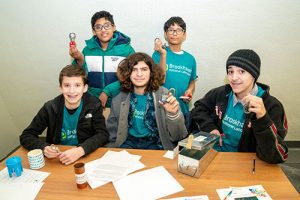
Ejiro Umaka of the Physics Department explained how sPHENIX, one of two detectors that captures particle collisions at the Relativistic Heavy Ion Collider, a DOE Office of Science User facility for nuclear physics research at Brookhaven, helps scientists further understand the nature of matter in our early universe.
During a STEM Expo organized by the Lab’s Workforce Development and Science Education Office, students were the ones asking questions. Scientists from across the Lab’s disciplines offered demonstrations that revealed the basic principles of vacuum chambers, electron beams, software that operates instrumentation used to view materials at the nanoscale, and more.
Science Bowl competitors also toured the National Synchrotron Light Source II, a DOE Office of Science User facility at Brookhaven.
Teams that did not move on to the competition’s final double elimination rounds had the chance to further test their know-how at a STEM Challenge. They quickly put their minds together to solve puzzles that revealed codes to unlock boxes filled with treats. The teams with the fastest times won gift bags.
Middle school STEM Challenge results: First Place: New Hyde Park Memorial High School; Second Place: Great Neck South Middle School (Team 2); Third Place: Plainedge Middle School
High school STEM Challenge results: First Place: Lindenhurst High School; Second Place: Long Beach High School; Third Place: Jericho High Schoo
Brookhaven National Laboratory is supported by the Office of Science of the U.S. Department of Energy. The Office of Science is the single largest supporter of basic research in the physical sciences in the United States and is working to address some of the most pressing challenges of our time. For more information, visit science.energy.gov.






